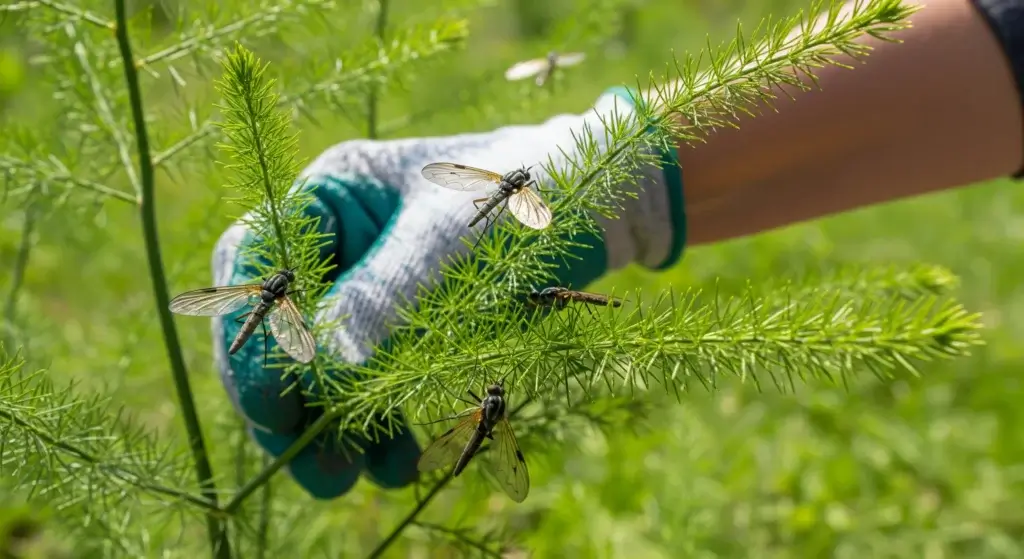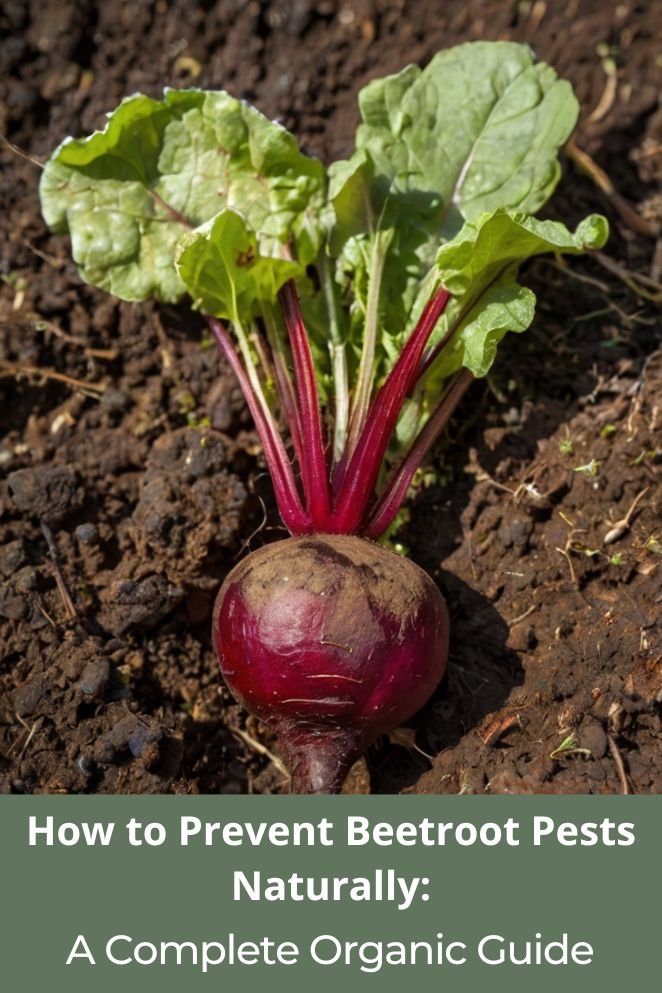
Growing beets? Cool. Letting bugs eat them? Not so cool.
You can keep things organic without turning your garden into a pest playground.
This guide breaks down simple, no-chemical tricks to stop freeloaders like aphids and leaf miners.
Think of it as building a tiny Beetroot Batcave—safe, strong, and pest-proof.
Let’s keep the bugs out and the harvest yours.
Understanding Common Beetroot Pests: Know Your Enemy
Before you go full ninja on pest control, it helps to know who’s crashing your beetroot party.
Here’s the rogue’s gallery of the usual suspects:
Aphids
These tiny plant vampires suck the life out of your beet greens and spread viruses like they’re going viral on TikTok.
They come in green, black, or gray—and they multiply fast. Left alone, they’ll turn your plants into wilted messes.
Flea beetles
Think of them as the popcorn machine of leaf damage.
They make a bunch of tiny holes in the leaves, giving them that “shotgun” look.
They’re tiny, dark, and bounce like fleas when you try to catch them. Young beets? Their favorite snack.
Leafminers
These sneaky larvae burrow through leaves like they’re drawing squiggles for fun.
They live between the leaf layers, causing tunnels and reducing your plant’s energy. It’s like graffiti, but inside the leaf.
Cutworms
These night crawlers are straight-up villains.
They slice through baby beet stems at soil level and leave your seedlings face-down like fallen dominoes.
Most of the damage happens while you’re asleep.
Root maggots
If your beets look great up top but are a mess underground, these guys might be the reason.
They tunnel into the roots and invite diseases in.
It’s basically rot from the inside out—not ideal when you’re growing food.
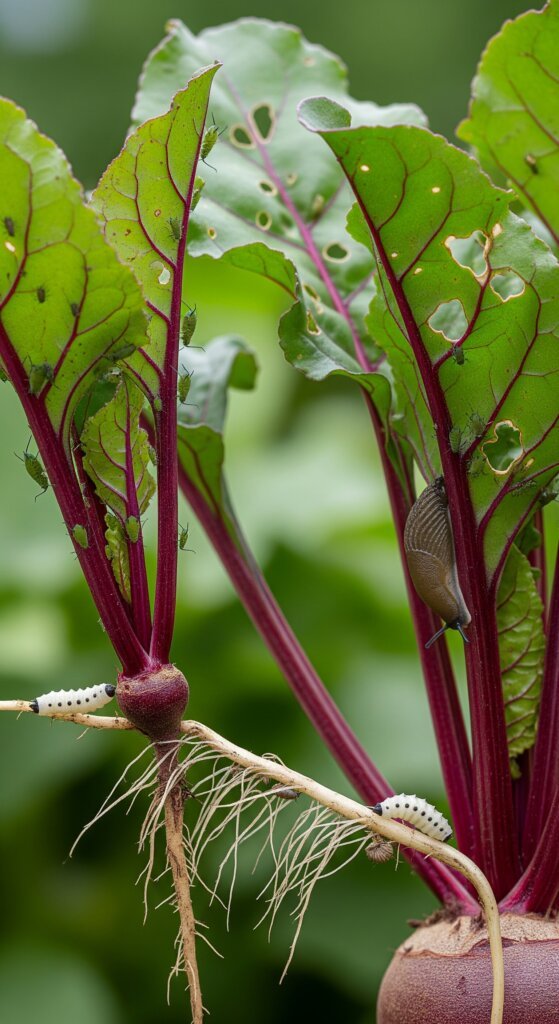
Physical Barriers: Your First Line of Defense
When it comes to protecting your beets, sometimes the best offense is a good defense—literally.
Physical barriers are like putting your plants in a VIP section with a bouncer at the door. No bugs allowed.
Here’s how to build your beetroot fortress:
Floating row covers
hese are like invisibility cloaks for your beets.
They stop flying pests like flea beetles and root flies from getting in and laying eggs.
Just toss them over right when you plant your seeds or seedlings and keep them on until harvest.
Pro tip: use a light, breathable fabric so sunlight and rain still get through—plants don’t want to feel like they’re living under a tarp.
Copper strips
Slugs and snails love beet leaves like a late-night snack, but copper? Not so much.
When their slimy bodies touch it, they get a little zap (nothing dramatic, just enough to make them rethink their life choices).
Line your garden beds with copper tape and they’ll slither somewhere else.
Fine mesh barriers
Think of these as baby gates for your seedlings.
Place fine mesh over seedbeds to keep pests out while your baby beets grow strong.
Once they’re big enough to handle a few nibbles, you can let them face the world.
Raised beds
Not just for looks.
Raised beds drain better, warm up faster, and give you more control over your setup.
Plus, they make it easier to add row covers, copper barriers, and even companion plants.
Companion Planting: Nature’s Pest Control System
Want to keep pests off your beets and make your garden look cool while doing it?
Meet companion planting—nature’s built-in pest control system.
It’s like setting your beets up with plant bodyguards and friendly neighbors who scare off the riff-raff.
Here’s the dream team:
Garlic, onions & chives
These strong-smelling plants confuse and repel pests like aphids, slugs, and beetles.
It’s like garlic breath for bugs—they hate it.
Tuck them between or around your beets and let the scent do the work.
Marigolds
Marigolds aren’t just pretty—they’ve got street smarts.
Their smell messes with pest radar, and they attract good bugs like ladybugs and parasitic wasps.
Basically, they host the insect version of a Marvel hero meetup.
Nasturtiums
These colorful rebels lure aphids away from your beets (yep, like a distraction in a heist movie).
Their flowers also bring in beneficial bugs who eat pests for lunch. Think of nasturtiums as the bait and the cavalry.
Herbs like dill, cilantro, and fennel
These flowering herbs are like luxury hotels for pest-eating insects.
Plant them nearby, and ladybugs, lacewings, and hoverflies will check in and handle your pest problems.
Bonus: they also make your garden smell amazing.
Lettuce and spinach
These leafy greens grow well with beets because they don’t hog space or nutrients.
They just hang out, fill the bed nicely, and help with ground cover. No drama, just good vibes.
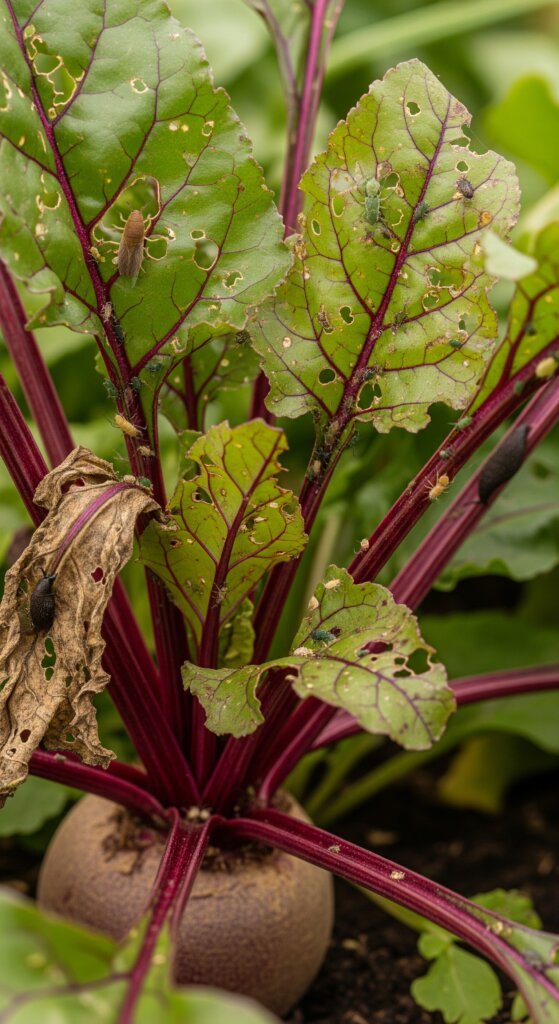
Beneficial Insects: Recruiting Natural Predators
You don’t have to fight every garden battle yourself—just call in some bug backup.
Beneficial insects are nature’s pest control squad.
Once they’re in your garden, they keep the bad bugs in check without you lifting a finger (or spraying anything toxic).
Here’s who you want on your team:
Ladybugs
These spotted legends love aphids.
One ladybug can eat 50 a day—basically the garden version of an all-you-can-eat buffet.
Want to keep them around? Plant a mix of flowers and skip the pesticides. Think of it as building them a bug-friendly Airbnb.
Lacewings
Lacewing adults are sweet—they sip nectar and chill. But their babies? Total savages.
Lacewing larvae munch on aphids, mites, and other soft-bodied pests like it’s their job (because it is).
Plant nectar-rich flowers and they’ll show up ready to work.
Predatory mites
You’ll probably never see them, but they’re there—chasing down spider mites and thrips.
They love moist, organic-rich gardens.
So if your soil’s healthy, they’ll stick around and handle pest drama behind the scenes.
Ground beetles
These guys clock in after dark and go after root maggots, cutworms, and other underground troublemakers.
Want them patrolling your garden? Add mulch, stones, or low plants where they can hide during the day.
They’re basically Batman with a shell.
Organic Sprays and Natural Repellents
Sometimes, even after setting up all the barriers, bug squads, and companion plants, a few stubborn pests still sneak through.
That’s when it’s time to break out the organic sprays—your garden’s backup plan that won’t mess with nature’s balance.
Here’s your go-to toolkit:
Neem oil
Neem oil messes with insect hormones, so they stop eating, laying eggs, and generally just fall apart (in a bug way).
Spray it once a week in the evening—it keeps the good bugs safe and prevents leaf burn. Think of it as ghosting pests… with science.
Insecticidal soap
Soft-bodied pests like aphids hate soap.
Mix a tablespoon or two of plain liquid dish soap (no detergent!) with a quart of water, spray it on, and boom—instant pest eviction.
It breaks down fast and doesn’t leave any toxic junk behind.
Diatomaceous earth
This fine, food-grade powder looks harmless, but to bugs, it’s like crawling through broken glass.
Sprinkle it dry around the base of your plants to stop crawling pests like ants, beetles, and slugs.
Warning: it only works when dry, so reapply after rain.
Garlic and chili pepper sprays
Blend garlic and hot peppers with water, strain it, and spray it on.
Pests hate the smell and taste—kind of like the garden version of pepper spray.
Bonus: vampires will definitely skip your beet patch.
Essential oil sprays
A few drops of peppermint, rosemary, or thyme oil mixed with water and a splash of soap (to help it stick) can keep pests away.
You get a fresh-smelling garden, they get the hint and leave.
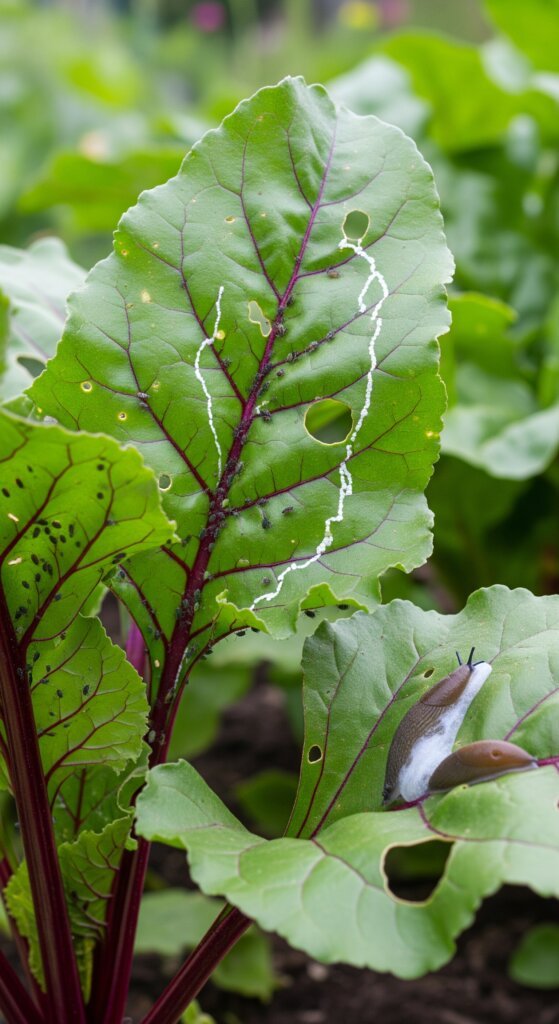
Soil Health and Cultural Practices
Strong plants start with strong soil.
If your beets are growing in healthy, well-fed dirt, they’re way better at fending off pests.
It’s kind of like hitting the gym and taking vitamins—you’re less likely to get taken down by the tiniest bug (literally).
Here’s how to keep your beetroot roots thriving:
Crop rotation
Pests love routine. If you plant beets in the same spot every year, you’re basically handing them a lease.
Rotate your beets with unrelated crops (like beans or lettuce) and give that bed a beet break for at least 3 years.
Break the pest cycle like you’re breaking up with an ex: no contact.
Proper spacing
Crowded plants trap humidity and invite trouble (mildew, bugs, drama).
Stick to the recommended spacing so air can flow and pests don’t feel cozy.
It’s like giving your plants their personal bubble.
Timing your plantings
Don’t go toe-to-toe with peak bug season if you can help it.
Time your beet planting for when local pest numbers are low.
Or try succession planting (small batches over time) so if one crop gets hit, the next might dodge the drama.
Soil amendments
Good soil = strong plants = fewer pest problems.
Add compost or aged manure to boost nutrients and keep soil structure in check.
Your beets will be healthier and bounce back faster from any bug nibbles.
Adequate irrigation
Keep soil consistently moist—not soggy.
Stressed plants (too thirsty or too soggy) are way more likely to get picked on by pests.
Beets want that just-right Goldilocks moisture.
Regular weeding
Weeds aren’t just annoying—they’re pest magnets.
Many beet pests hang out on common weeds, so rip them out and keep your growing space clean.
Bonus: your beets won’t have to compete for nutrients or water.
Monitoring and Early Detection
Want to avoid a full-blown beetroot bug crisis? Catch problems early.
A little weekly snooping goes a long way—and your beets will thank you for it.
Weekly inspections
Flip leaves, check around the soil, and look for weird spots, holes, or slime trails.
Most bugs hide under the leaves or in the soil, so don’t just glance—get in there.
Yellow sticky traps
These little traps don’t just catch pests—they spill the tea on what’s flying around your garden.
Stick them near your plants or at the edges of your patch to keep an eye on any incoming trouble.
Damage assessment
Each pest leaves a calling card. Shot-hole leaves? Probably flea beetles.
Squiggly lines? Leafminers.
Knowing who did what helps you fight back smart, not hard.
Record keeping
Jot down what you see and what works. Did neem oil crush the aphid party last year? Write it down.
This info helps you fine-tune your game each season.
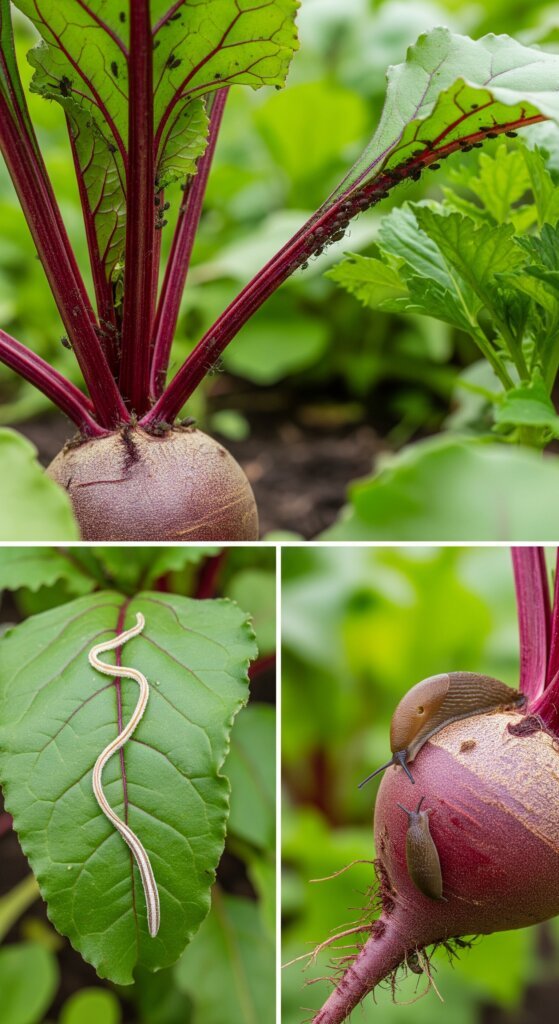
Seasonal Prevention Strategies
Pests don’t take a season off—so neither should your prevention strategy.
Here’s your year-round game plan:
Spring preparation
Prep your soil, lay down those row covers, and get your companion plants growing before pests even show up.
It’s like setting traps before the heist starts.
Summer maintenance
This is prime beet-growing season and peak bug party time.
Keep monitoring, support your beneficial bug army, and spray if needed.
Don’t slack—this is the main event.
Fall cleanup
After the harvest, clear out weeds, dead plants, and any suspicious bug hangouts.
Compost the healthy stuff, toss anything diseased. Don’t give pests a place to crash for winter.
Winter planning
Take stock: What worked? What flopped? Plan your rotations, order seeds, and redesign your layout to make pests’ lives miserable next season.
Conclusion: Building a Resilient Beetroot Garden
Keeping pests off your beets isn’t about wiping them all out—it’s about keeping them in check without turning your garden into a chemical war zone.
Mix and match your tools: row covers, companion plants, good bugs, homemade sprays, and solid garden habits.
It’s all about balance. Like building a tiny, leafy ecosystem where your beets thrive and the pests stay in the “mildly annoying” zone.
Start small. Add what works best for your space, then tweak as you go.
The more you learn what your garden likes, the better your harvest gets.


